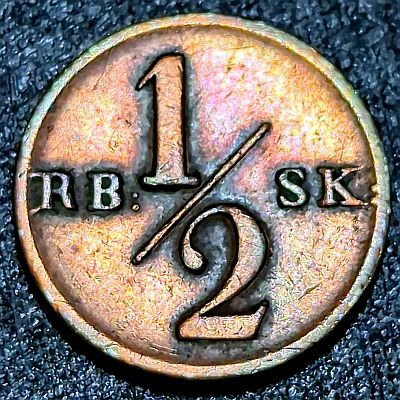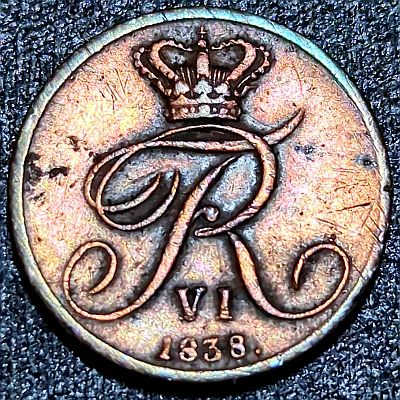A simple, elegant design

Denmark’s financial situation was, precarious, in the early 1800s. The largest single event was the Danish state bankruptcy of 1813 following the Napoleonic wars. By the 1830s, the currency was somewhat more stable. At that time, Denmark’s currency was the Rigsbankdaler, which was divided up into 16 Rigsdaler Courant and 96 Rigsbankskilling. This coin is even smaller, worth only 1/2 of a Rigsbankskilling, or 1/192 of a Rigsbankdaler. Denmark did not go decimal until 1875.
Initially I simply liked the design of this piece – I am a big fan of a big number on a coin, not to mention a fraction in a neat font like this one. Looking closer though, my coin has a number of interesting features. The first of which is that to the left of the R, there is a couple of small die cracks. That is, the die used to imprint this pattern on the coin has the design reversed – the number and lettering, instead of being raised, are sunk into the die. After striking thousands of coins, dies start to wear out, and thinner pieces, like the thin line between the R and the edge can start to crack. Left unchecked, that piece would possibly eventually break off, which would produce a coin with a solid raised section from the left of the R to the edge of the coin. The colon to the right of SK is also on the edge of the rim, which is different to the example on the Numista page for the 1838 1/2 Rigsbankskilling.

The obverse of the coin features the crowned monogram of King Frederick VI and the date. My coin has some nice colourful toning, but also a few scratches and marks. Frederick was king of Denmark from 1808, as well as being King of Norway from 1808-1814. Frederik VI was a popular King; he appeared as the epitome of an absolutist father figure. At the same time he, the Queen and their daughters personified the comfortable bourgeois family, not least when they were sailing on the canals in Frederiksberg Have, visible to the population.
Finally, the edge is the other interesting part of my specimen:

Numista originally described it as smooth. I’m not sure if some examples are. If you know, please do let me know. UCoin describes the edge as “Smooth with a notched”. A notched what? I’ve just gone with “line” in updating Numista’s description. But my piece doesn’t have any old regular line around the middle of the edge. No, on the right side of mine (looking at the obverse), the line wanders up near the obverse, and loses much of the notching. If anyone has one of these, please do let me know if this is common!


Leave a Reply